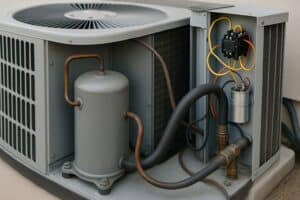Table of Contents:
- Introduction
- What Is an AC Compressor, and Why Is It Important?
- Signs Your AC Compressor is Malfunctioning
- Common Causes of Compressor Cycling
- How to Diagnose Compressor Issues
- Practical Steps to Fix Cycling Problems
- Preventive Measures for Better AC Performance
- When to Call a Professional
- Final Thoughts on Maintaining a Healthy AC System
Key Takeaways:
- Understand why your AC compressor cycles on and off without effective cooling.
- Learn practical troubleshooting steps to address this issue.
- Gain insights into preventive measures to enhance your AC system’s efficiency.
Introduction
Facing a scenario where your AC compressor kicks on and off but no cold air is produced can be especially frustrating when the heat is rising. Not only does this issue disrupt the comfort of your home, but it can also lead to increased energy consumption and higher utility bills. Many homeowners initially overlook these symptoms, thinking they might resolve on their own, only to realize the importance of early intervention when the system worsens.

Beyond just the immediate discomfort, this malfunction stresses the entire HVAC system. Frequent compressor cycling forces components to work harder than they need to, accelerating wear and tear. If left unchecked, minor issues can escalate into major, more costly repairs or even full system replacements.
Grasping the underlying reasons for this problem is essential for maintaining a working and effective air conditioning system. Understanding the connection between symptoms and root causes empowers you to take timely action, whether through simple troubleshooting or by seeking professional help. Staying informed ultimately safeguards your home’s comfort and your budget.
What Is an AC Compressor, and Why Is It Important?
The AC compressor is the core of your home’s cooling system. It distributes refrigerant across the coil network, aiding in heat release and absorption during the cooling process. If the compressor did not generate the required pressure differences, your air conditioner would fail to cool your home.
Inside your outdoor AC unit, the compressor converts low-pressure refrigerant into high-pressure gas. This compressed refrigerant moves into coils, losing heat and changing to a liquid. The liquid then travels to the indoor unit, evaporating into a gas, absorbing the heat inside your home, and transferring it outside.
Without this crucial component functioning correctly, the entire system’s cooling capabilities are compromised, creating an uncomfortable indoor climate. Even if all other parts work correctly, a faulty compressor alone can make your AC ineffective. Recognizing its vital role highlights why addressing compressor issues promptly is so important.
Signs Your AC Compressor is Malfunctioning
The symptoms of a faltering AC compressor can vary, yet some signs are unmistakably indicative of impending issues. One significant warning sign is short cycling, where the compressor turns on and off at rapid intervals. This behavior disrupts comfortable home temperatures and puts undue stress on the system, potentially leading to premature wear and tear. Another red flag is when the AC system runs, but the air from the vents feels warm or lukewarm rather than cool. The compressor often struggles to maintain the proper pressure for effective refrigerant movement. Over time, the inability to achieve and sustain adequate cooling could lead to total compressor failure. You might also notice unusual noises from the outdoor unit, such as clanking, rattling, or hissing sounds. These noises often signal internal damage or leaks. As highlighted by the U.S. Department of Energy, many common air conditioner problems, including those related to the compressor, can be spotted early by carefully observing performance and sounds. Monitoring for these auditory cues, alongside system performance, gives you a better chance of addressing problems before they spiral into bigger, more expensive repairs.
Common Causes of Compressor Cycling
Understanding what causes a compressor to cycle frequently can help develop an effective strategy to restore smooth operation. A wrongly set thermostat is one frequent contributor. If the thermostat is programmed with an improper temperature differential or is located near heat sources, such as lamps or windows, it may cause the system to cycle erratically.
In addition to thermostat issues, refrigerant level imbalances can significantly disrupt compressor performance. When refrigerant is too low, the compressor struggles to pressurize the system properly, causing it to switch on and off more frequently. This reduces system efficiency and risks damaging the compressor if the problem persists.
Electrical problems are another common trigger for abnormal cycling. Faulty capacitors, damaged wiring, or corroded terminals can all interfere with the electrical signals that control the compressor’s operation. Diagnosing and addressing these electrical faults promptly is crucial to restore proper cycling patterns and avoid further complications.
How to Diagnose Compressor Issues
Diagnosing the root causes of compressor issues begins with a simple thermostat assessment. Ensuring it’s appropriately set — and perhaps recalibrated if necessary — can sometimes resolve cycling anomalies instantly. It’s also wise to check if the thermostat’s batteries are fresh and the device is free from dust or obstruction. Following the thermostat check, inspecting the refrigerant levels is crucial, as low levels often signal leaks or other issues that need immediate attention. Low refrigerant reduces system efficiency and can trigger short cycling, so seeking professional help is essential if you suspect a leak. Topping off refrigerant without fixing the underlying leak only leads to recurring problems. If you’re unsure where to start with compressor troubleshooting, this guide from wikiHow offers a helpful step-by-step approach for basic checks you can do safely on your own. Another area worth examining involves the electrical connections within the unit. Visual inspections for signs of corrosion, loose wiring, or burnt components can reveal why your compressor behaves erratically. While homeowners can perform basic checks, in-depth electrical diagnostics should be left to certified technicians to ensure safety and accuracy.
Practical Steps to Fix Cycling Problems
- Thermostat adjustment: Adjusting settings to match your cooling needs can reduce unnecessary cycling. Ensure your thermostat is level, properly calibrated, and located in a draft-free area away from direct sunlight. Sometimes, upgrading to a smart thermostat can regulate temperature more accurately and prevent frequent cycling.
- Filter maintenance: Dusty or clogged filters hamper airflow, straining the system and potentially escalating compressor cycling. Set reminders to replace or clean these filters at least once every one to three months, depending on your household environment. Better airflow means less strain on the compressor and a longer lifespan for the system.
- Unblock vents: Ensuring that all vents in your home are unobstructed by furniture or decor helps to ensure seamless air circulation, allowing your system to distribute cool air uniformly across all rooms. Poor airflow causes temperature inconsistencies that trick the thermostat into more frequent activation, leading to unnecessary cycling and more excellent wear on the compressor.
Preventive Measures for Better AC Performance
Preventive measures can significantly prolong the life of your AC system while preserving its efficiency. Frequently changing filters is one of the easiest but most impactful actions any homeowner can take. A clean filter enhances air quality and helps the compressor by ensuring adequate airflow throughout the system.
Equally important is scheduling routine professional maintenance. Professional inspections often uncover hidden inefficiencies, refrigerant issues, or worn-out components long before they become serious problems. Staying proactive with knowledge and care will save money, prevent breakdowns, and ensure superb comfort even during the hottest days.
When to Call a Professional
While some AC maintenance can be handled with DIY approaches, professional expertise is essential in some situations. Persistent refrigerant leaks, for instance, require specialized equipment and training to detect, contain, and recharge properly. Mishandling refrigerants can cause environmental harm and personal injury.
Similarly, advanced electrical issues require the attention of an experienced technician to avoid injury or further damage to the system. High-voltage components within an AC unit are dangerous if tampered with improperly. Even seemingly minor electrical faults can escalate quickly if not diagnosed and repaired correctly.
Enlisting the expertise of a professional ensures your cooling system remains in prime operation. Experienced technicians can also provide long-term solutions rather than temporary fixes, saving money and extending your system’s lifespan. Investing in professional services when needed is always a wise decision for homeowners aiming for reliability and peace of mind.
Final Thoughts on Maintaining a Healthy AC System
An efficiently operating air conditioning system is essential for maintaining a pleasant indoor environment. As outside temperatures climb, the last thing any homeowner wants is an unreliable cooling system struggling to keep up. Understanding the common causes behind compressor cycling provides the foundation for timely troubleshooting and effective repairs.
By executing preventive care, you can ensure that your AC remains dependable and efficient. Regular filter changes, routine professional inspections, and attentiveness to minor warning signs make a significant difference. These proactive actions improve the system’s productivity and lower energy consumption and operational costs.
Routine checks and maintenance are crucial for minimizing breakdowns and extending longevity. They help you stay cool and comfortable without unexpectedly high energy costs. A little vigilance now can save significant headaches—and dollars—later, ensuring your home remains a refreshing retreat no matter how hot it gets outside.






